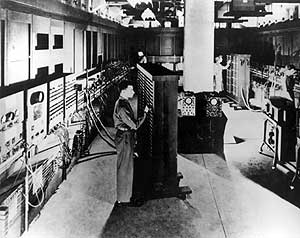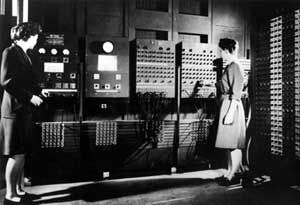ENIAC

ENIAC

Scholars argue about its claims as the world's first all electronic computer and the courts have ruled otherwise, but when the University of Pennsylvania's "mathematical brain" was made public in 1946 it was an incredible breakthrough that could compute mathematical problems with breathtaking speed.
ENIAC stands for Electronic Numerical Integrator and Computer. It was a secret World War II military project carried out by John Mauchly, a 32-year-old professor at Penn's Moore School of Electrical Engineering and John Presper Eckert Jr., a 24-year-old genius inventor and lab assistant. The challenge was to speed up the tedious mathematical calculations needed to produce artillery firing tables for the Army. ENIAC was not completed until after the war but it performed until 1955 at Aberdeen, Md. ENIAC was enormous. It contained 17,500 vacuum tubes, linked by 500,000 soldered connections. It filled a 50-foot long basement room and weighed 30 tons. Today, a single microchip, no bigger than a fingernail, can do more than those 30 tons of hardware.
About 10 percent of the historic computer lives on in the same basement room where it was created. ENIAC's 50th anniversary was celebrated in 1996 with a visit by Vice President Al Gore. What was left of the old computer was fired up one last time.
ENIAC is generally closed but special arrangement can be made to see it by contacting the University's electrical engineering school at 33rd and Walnut.



